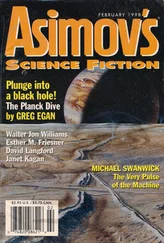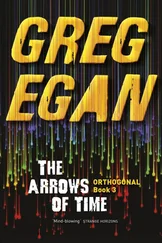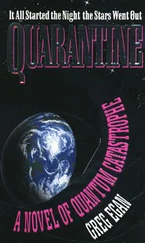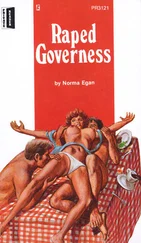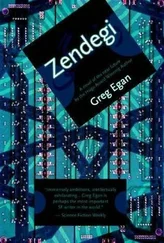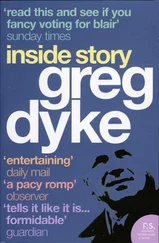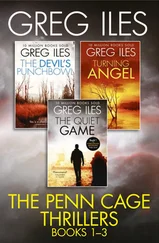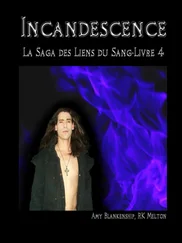"The question then," Tan said, "is how are the two symmetries related? In our last calculation we assumed that the symmetries of space always acted in a direction perpendicular to the time symmetry. But do we have any evidence for that?"
Roi hoped Gul was filling their children's minds with ideas that would prepare them for questions like this. She had been raised with an understanding of three perpendicular directions in space — garm/sard, rarb/sharq, shomal/junub — and if you added time as a fourth, it seemed obvious that it ought to be measured perpendicular to all three. Certainly, any clock you carried with you would measure time that way, and even in the abstract world of Tan's geometry, at any given time and place you could simply pick four perpendicular directions.
However, the directions of symmetry weren't a matter of choice or convenience; they were properties of the geometry itself. And while the framework for the calculations would become more complicated if the two symmetries were allowed the freedom to slant against each other, it would be even worse if they could not rely on a measure of time in which the geometry was unchanging.
Roi said, "What would count as evidence?"
Tan couldn't answer that immediately. He took a sheet of skin and started doodling. "Throw out one dimension of space, the one that takes us out of the plane of the Incandescence, and use that instead to picture time." He drew a point for the Hub, then sketched a circle around it for their old, un-Jolted orbit. "The symmetry in time takes this circle into another one in the future, tracing out a cylinder." He sketched in the cylinder, drawing lines rising straight up from the circle to indicate the direction in which it could be pushed without its geometry changing.
Roi said, "And if the time symmetry isn't perpendicular to the rotational symmetry?" She scratched a second diagram beside the first, in which the lines that carried the circle forward in time wound around the cylinder in helices. "But wouldn't we always be able to straighten out these lines?" she said. "The geometry doesn't change, whether you move around the cylinder as you travel along its length, or just slide straight up and down. It's all the same."
Tan thought for a moment. "With one cylinder you could always do that, but don't forget the rest of the geometry." He drew in a second, larger orbit on Roi's diagram, then sketched in helices with a different, steeper pitch. "Suppose the time symmetry makes a different angle with the rotational symmetry at different distances from the Hub. We're free to combine this whole motion with any fixed amount of rotation around the Hub, but we're not free to rotate around the Hub by different angles at different distances, and that's what we'd need in order to straighten everything out."
Roi said, "So there'd be a kind of unavoidable twist in the geometry?" She pondered this. "Then wouldn't motion around the Hub in the direction of the twist be different from motion in other directions?"
"That sounds plausible," Tan said.
"When we throw a stone out of the plane of the Incandescence," Roi said, "it completes the orbit in much less time than it takes to fall down and rise up again. It's almost as if it's being swept around the axis of symmetry, forcing it to go around faster than the other cycle it's completing, the shomal-junub cycle."
Tan said, "I think you've just answered the question. There might turn out to be some other explanation, but for now we definitely can't assume that the symmetries are perpendicular."
That would make the calculations harder, but at least they were doing it for a reason. Roi felt buoyed; the idea that they could anticipate a feature of the geometry that might allow it to conform to the new observations was encouraging. Most of what she'd seen in the void remained utterly mysterious to her, but they were moving in the right direction.
"There's one more thing we need to decide before we call in the calculating team," Tan said. "How are we going to measure distances from the Hub now?"
In the previous calculation, they'd described each point's relationship to the Hub by the size of the sphere on which it lay. You didn't need to worry about the actual, messy curved geometry all the way from the point to the Hub itself; instead you imagined rotating the point around the Hub in all possible directions, sweeping out a sphere whose surface area would increase the further the point was from the Hub.
With the spherical symmetry gone, they could no longer do this. They could replace the spheres with circles — rotating each point around the axis of symmetry and then considering the circumference of the circle it swept out — but away from the plane of the Incandescence it wasn't clear how those circles would be related to each other.
Ruz appeared at the entrance to the Chamber. He greeted them politely and apologized for interrupting, but Roi could tell from the way he hunched against the wall that he had something he urgently needed to say.
"We're seeing more flares from the Wanderer," he announced. "Nine, in the last report I've received." While Roi had been visiting Bard and Neth, Ruz had arranged a group of new recruits to stay at the junub edge, with pairs climbing up through the crack in the wall each time it was safe, to make observations.
"We've felt no new Jolt," Tan said.
"No," Ruz replied, "we've been lucky. But if this continues, it's only a matter of time before another one strikes us. We're also seeing the Wanderer's orbit changing: it's losing its inclination, coming closer to the plane of the Incandescence."
Roi felt a crushing sense of hopelessness descend, but she struggled to fight it off. One tunnel was almost complete, and Neth would help Bard sort out any problems with the flow. They were tracking the Wanderer heartbeat by heartbeat. Now it was up to the theorists to find the way forward, to draw the map that showed the way to safety.
She addressed Tan. "We should assemble the calculating team, next shift."
"All right," he said. "But what about the question of distance from the Hub?"
Roi thought for a while. "There's one symmetry that's always present, that we forgot to mention: the geometry really doesn't care how we describe it." You could wrap space-time in numbers in countless different ways, but the underlying shape was oblivious to the packaging. "We don't know the best way to express distance from the Hub, and even if we make a certain guess now it might turn out to make things harder. So we should give ourselves room to manoeuvre: we should set up the templates so we can choose the easiest scheme at any point in the calculations."
Tan concurred. He said, "I'll go and tell the calculating team."
When he'd left, Ruz said, "I'd better go and send the messengers back to get the next report."
Roi said, "Remember Jos?"
"Jos?"
"One of the people we met with the light machine?"
Ruz looked tired. "Vaguely. Why?"
"She's had an idea for something much faster than any messenger. I think you need to talk to her."
Rakesh spooned chillied dhal into his mouth with an urgency that had nothing to do with hunger. The longer he spent among the Arkdwellers, the more he needed to reinforce his sense of presence in his own neglected body, and the familiar taste and aroma brought him back to himself like nothing else did.
"I'm going mad," he announced. "One more month of this, and you can erase me and break the news to my backup."
Parantham said, "Don't expect my sympathy. Just because the Arkdwellers' culture turned out to be resilient, it doesn't mean you were right to take a risk with it."
" Resilient? I think the word you're looking for is catatonic." Sweat was pouring down the back of his neck from the spices, but he kept eating without pause, and without diluting the heat with bread or rice.
Читать дальше

